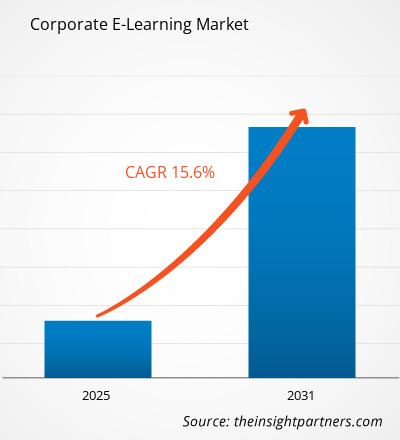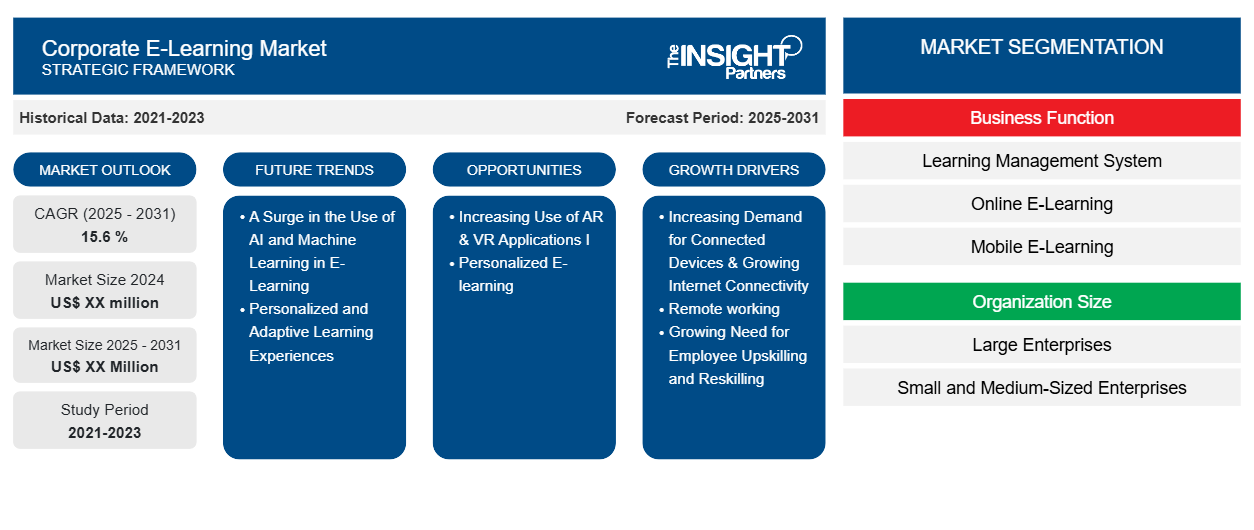من المتوقع أن يسجل سوق التعلم الإلكتروني للشركات معدل نمو سنوي مركب بنسبة 15.6٪ من عام 2024 إلى عام 2031، مع توسع حجم السوق من XX مليون دولار أمريكي في عام 2024 إلى XX مليون دولار أمريكي بحلول عام 2031.
تم تقسيم التقرير حسب وظيفة العمل (نظام إدارة التعلم (LMS)، التعلم الإلكتروني عبر الإنترنت، التعلم الإلكتروني عبر الهاتف المحمول، وغيرها)، حجم المنظمة (المؤسسات الكبيرة، المؤسسات الصغيرة والمتوسطة الحجم)، النشر (السحابة، في الموقع). تم تقسيم التحليل العالمي بشكل أكبر على المستوى الإقليمي والدول الرئيسية. يقدم التقرير القيمة بالدولار الأمريكي للتحليل والقطاعات المذكورة أعلاه
غرض التقرير
يهدف تقرير سوق التعلم الإلكتروني للشركات الصادر عن The Insight Partners إلى وصف المشهد الحالي والنمو المستقبلي وأهم العوامل الدافعة والتحديات والفرص. وسيوفر هذا رؤى لمختلف أصحاب المصلحة في الأعمال التجارية، مثل:
- مزودي/مصنعي التكنولوجيا: لفهم ديناميكيات السوق المتطورة ومعرفة فرص النمو المحتملة، وتمكينهم من اتخاذ قرارات استراتيجية مستنيرة.
- المستثمرون: إجراء تحليل شامل للاتجاهات فيما يتعلق بمعدل نمو السوق، وتوقعات السوق المالية، والفرص المتاحة عبر سلسلة القيمة.
- الهيئات التنظيمية: لتنظيم السياسات ومراقبة الأنشطة في السوق بهدف تقليل الانتهاكات والحفاظ على ثقة المستثمرين ودعم سلامة السوق واستقرارها.
تجزئة سوق التعلم الإلكتروني للشركات
وظيفة الأعمال
- نظام إدارة التعلم
- التعلم الإلكتروني عبر الإنترنت
- التعلم الإلكتروني عبر الهاتف المحمول
- آحرون
حجم المنظمة
- الشركات الكبيرة
- الشركات الصغيرة والمتوسطة الحجم
النشر
- سحاب
- في الموقع
الجغرافيا
- أمريكا الشمالية
- أوروبا
- آسيا والمحيط الهادئ
- أمريكا الجنوبية والوسطى
- الشرق الأوسط وأفريقيا
قم بتخصيص هذا التقرير ليناسب متطلباتك
ستحصل على تخصيص لأي تقرير - مجانًا - بما في ذلك أجزاء من هذا التقرير، أو تحليل على مستوى الدولة، وحزمة بيانات Excel، بالإضافة إلى الاستفادة من العروض والخصومات الرائعة للشركات الناشئة والجامعات
-
احصل على أهم اتجاهات السوق الرئيسية لهذا التقرير.ستتضمن هذه العينة المجانية تحليلاً للبيانات، بدءًا من اتجاهات السوق وحتى التقديرات والتوقعات.
محركات نمو سوق التعلم الإلكتروني للشركات
- التخفيف من فجوة المهارات وتحسين مهارات القوى العاملة: إن التطور التكنولوجي السريع والمناظر الطبيعية الديناميكية للأعمال تدفع الشركات إلى التعلم الإلكتروني كاستراتيجية حاسمة لمعالجة فجوات المهارات والحفاظ على القدرة التنافسية للقوى العاملة. وتشهد المنظمات اضطرابًا تكنولوجيًا غير مسبوق، مما يتطلب التعلم والتطوير المستمر لمواكبة المهارات الناشئة ومجالات المعرفة. وتمكن منصات التعلم الإلكتروني للشركات الشركات من نشر برامج تدريبية مستهدفة بسرعة، وتسهيل التطوير المهني المستمر، وإنشاء أنظمة بيئية تعليمية قابلة للتكيف يمكنها الاستجابة بسرعة لمتطلبات المهارات المتغيرة. ويعكس هذا المحرك الحاجة الملحة إلى حلول تعليمية مرنة وقابلة للتطوير يمكنها تحويل قدرات القوى العاملة في الوقت الفعلي.
- العمل عن بعد والتعلم من خلال القوى العاملة الموزعة: إن التحول الجذري نحو بيئات العمل عن بعد والهجينة يعمل على تسريع تبني التعلم الإلكتروني للشركات. وتحتاج المؤسسات إلى منصات تعليمية مرنة وسهلة الوصول إليها يمكنها تدريب القوى العاملة الموزعة وإشراكها بشكل فعال عبر مواقع جغرافية متعددة وبنى تحتية تكنولوجية. وتوفر حلول التعلم الإلكتروني منهجيات تدريب قابلة للتطوير وموحدة تضمن تطوير المهارات بشكل متسق ونقل المعرفة والتوافق التنظيمي بغض النظر عن ترتيبات العمل المادية. ويؤكد هذا المحرك على الدور الحاسم لمنصات التعلم الرقمية في الحفاظ على اتصال القوى العاملة والإنتاجية والتطوير المهني المستمر في بيئات العمل اللامركزية بشكل متزايد.
الاتجاهات المستقبلية لسوق التعلم الإلكتروني للشركات
- التعلم الجزئي واستراتيجيات المحتوى التي تركز على المهارات: يشهد سوق التعلم الإلكتروني للشركات اتجاهًا كبيرًا نحو التعلم الجزئي واستراتيجيات المحتوى التي تركز على المهارات بشكل كبير. تبتعد المؤسسات عن وحدات التدريب التقليدية الطويلة نحو تجارب التعلم الأكثر قابلية للهضم والتي يمكن استهلاكها بسرعة وتطبيقها على الفور. يؤكد هذا الاتجاه على إنشاء محتوى تعليمي معياري صغير الحجم يدعم اكتساب المهارات المرنة عند الطلب، ويمكِّن التعلم المستمر، ويتماشى مع تفضيلات القوى العاملة الحديثة لتطوير المعرفة الشخصية والفعالة. من خلال دعم مناهج التعلم الأكثر مرونة وتركيزًا، يمكن لمنصات التعلم الإلكتروني للشركات تعزيز قدرة القوى العاملة على التكيف وفعالية التعلم.
- الاستخدام المتزايد لتحليلات البيانات لقياس فعالية التعلم: مع استمرار المؤسسات في الاستثمار في منصات التعلم الإلكتروني، هناك تركيز متزايد على الاستفادة من تحليلات البيانات لقياس فعالية برامج التدريب. تتضمن أنظمة إدارة التعلم (LMS) وغيرها من منصات التعلم الإلكتروني الآن أدوات تحليلية متقدمة تتبع تقدم المتعلم ومشاركته وأدائه. تسمح هذه الرؤى القائمة على البيانات للشركات بتقييم تأثير التدريب على أداء الموظفين وأهداف المؤسسة. من خلال تحليل المقاييس مثل معدلات الإكمال ونتائج الاختبارات والتطبيق في العالم الحقيقي، يمكن للشركات تحسين برامج التدريب الخاصة بها باستمرار، مما يجعلها أكثر فعالية ومواءمة مع نتائج الأعمال. يساعد هذا الاتجاه الشركات على ضمان أن مبادرات التعلم الإلكتروني الخاصة بها توفر عائدًا قابلاً للقياس على الاستثمار وتحسينات ملموسة في أداء الموظفين.
فرص سوق التعلم الإلكتروني للشركات
- الذكاء الاصطناعي وتجارب التعلم الشخصية: يمثل دمج تقنيات الذكاء الاصطناعي والتعلم الآلي فرصة تحويلية في سوق التعلم الإلكتروني للشركات. يمكن للمنصات المتقدمة التي تعمل بالذكاء الاصطناعي تقديم تجارب تعليمية شخصية للغاية وقابلة للتكيف مع المحتوى والوتيرة والتعقيد بشكل ديناميكي بناءً على ملفات تعريف المتعلمين الفردية وأدائهم. يمكن لهذه الأنظمة الذكية تقديم ملاحظات في الوقت الفعلي وتحديد فجوات المهارات والتوصية بمسارات التعلم المستهدفة وإنشاء تجارب تدريبية غامرة وتفاعلية. تمتد الفرصة إلى ما هو أبعد من إدارة التعلم التقليدية، مما يوفر للمؤسسات القدرة على تطوير أنظمة بيئية تعليمية متطورة تعتمد على البيانات تعمل على تحسين تطوير مهارات القوى العاملة واكتساب المعرفة.
- تقنيات التعلم الغامر: إن ظهور تقنيات التعلم الغامر مثل الواقع الافتراضي والواقع المعزز والواقع المختلط يخلق فرصة كبيرة لحلول التعلم الإلكتروني المبتكرة للشركات. يمكن لهذه التقنيات تحويل مناهج التدريب التقليدية من خلال إنشاء بيئات تعليمية تفاعلية وجذابة تحاكي سيناريوهات العالم الحقيقي، وتمكن التعلم التجريبي، وتوفر مساحات آمنة لممارسة المهارات وتطبيق المعرفة. يمكن لمنصات التعلم الغامر دعم متطلبات التدريب المعقدة في الصناعات مثل التصنيع والرعاية الصحية والخدمات الفنية والاستجابة للطوارئ، مما يوفر مستويات غير مسبوقة من المشاركة والاحتفاظ وتطوير المهارات العملية.
رؤى إقليمية حول سوق التعلم الإلكتروني للشركات
لقد قام المحللون في Insight Partners بشرح الاتجاهات والعوامل الإقليمية المؤثرة على سوق التعلم الإلكتروني للشركات طوال فترة التوقعات بشكل شامل. يناقش هذا القسم أيضًا قطاعات سوق التعلم الإلكتروني للشركات والجغرافيا في جميع أنحاء أمريكا الشمالية وأوروبا ومنطقة آسيا والمحيط الهادئ والشرق الأوسط وأفريقيا وأمريكا الجنوبية والوسطى.

- احصل على البيانات الإقليمية المحددة لسوق التعلم الإلكتروني للشركات
نطاق تقرير سوق التعلم الإلكتروني للشركات
| سمة التقرير | تفاصيل |
|---|---|
| حجم السوق في عام 2024 | XX مليون دولار أمريكي |
| حجم السوق بحلول عام 2031 | XX مليون دولار أمريكي |
| معدل النمو السنوي المركب العالمي (2025 - 2031) | 15.6% |
| البيانات التاريخية | 2021-2023 |
| فترة التنبؤ | 2025-2031 |
| القطاعات المغطاة |
حسب وظيفة العمل
|
| المناطق والدول المغطاة |
أمريكا الشمالية
|
| قادة السوق وملفات تعريف الشركات الرئيسية |
|
كثافة اللاعبين في سوق التعلم الإلكتروني للشركات: فهم تأثيرها على ديناميكيات الأعمال
يشهد سوق التعلم الإلكتروني للشركات نموًا سريعًا، مدفوعًا بالطلب المتزايد من المستخدم النهائي بسبب عوامل مثل تفضيلات المستهلكين المتطورة والتقدم التكنولوجي والوعي المتزايد بفوائد المنتج. ومع ارتفاع الطلب، تعمل الشركات على توسيع عروضها والابتكار لتلبية احتياجات المستهلكين والاستفادة من الاتجاهات الناشئة، مما يؤدي إلى زيادة نمو السوق.
تشير كثافة اللاعبين في السوق إلى توزيع الشركات أو المؤسسات العاملة في سوق أو صناعة معينة. وهي تشير إلى عدد المنافسين (اللاعبين في السوق) الموجودين في مساحة سوق معينة نسبة إلى حجمها أو قيمتها السوقية الإجمالية.
الشركات الرئيسية العاملة في سوق التعلم الإلكتروني للشركات هي:
- شركة أبسورب للبرمجيات
- أنظمة أدوبي
- حجر الأساس
- ساب اس اي
- شركة سكيلسوفت
- أوراكل
إخلاء المسؤولية : الشركات المذكورة أعلاه ليست مرتبة بأي ترتيب معين.

- احصل على نظرة عامة على أهم اللاعبين الرئيسيين في سوق التعلم الإلكتروني للشركات
نقاط البيع الرئيسية
- التغطية الشاملة: يغطي التقرير بشكل شامل تحليل المنتجات والخدمات والأنواع والمستخدمين النهائيين لسوق التعلم الإلكتروني للشركات، مما يوفر صورة شاملة.
- تحليل الخبراء: تم تجميع التقرير على أساس الفهم العميق لخبراء الصناعة والمحللين.
- معلومات محدثة: يضمن التقرير أهمية الأعمال التجارية بسبب تغطيته للمعلومات الحديثة واتجاهات البيانات.
- خيارات التخصيص: يمكن تخصيص هذا التقرير لتلبية متطلبات العملاء المحددة وبما يتناسب مع استراتيجيات العمل بشكل مناسب.
وبالتالي، يمكن أن يساعد تقرير البحث حول سوق التعلم الإلكتروني للشركات في تمهيد الطريق لفك شفرة وفهم سيناريو الصناعة وآفاق النمو. ورغم وجود بعض المخاوف المشروعة، فإن الفوائد الإجمالية لهذا التقرير تميل إلى التفوق على العيوب.
- التحليل التاريخي (سنتان)، سنة الأساس، التوقعات (7 سنوات) مع معدل النمو السنوي المركب
- تحليل PEST و SWOT
- حجم السوق والقيمة / الحجم - عالمي، إقليمي، بلد
- الصناعة والمنافسة
- مجموعة بيانات إكسل
التقارير الحديثة
شهادات العملاء
سبب الشراء
- اتخاذ قرارات مدروسة
- فهم ديناميكيات السوق
- تحليل المنافسة
- رؤى العملاء
- توقعات السوق
- تخفيف المخاطر
- التخطيط الاستراتيجي
- مبررات الاستثمار
- تحديد الأسواق الناشئة
- تحسين استراتيجيات التسويق
- تعزيز الكفاءة التشغيلية
- مواكبة التوجهات التنظيمية























 احصل على عينة مجانية ل - سوق التعلم الإلكتروني للشركات
احصل على عينة مجانية ل - سوق التعلم الإلكتروني للشركات